
The biggest challenge for marketers is how to engrave the brand image in the customer’s mind. You wonder why customers spend so much time on the website to research information but still do not end up buying the product.
The core of the problem may come from the fact that your business has not built a clear experience process with customers. In other words, the process of interacting with customers to achieve the ultimate goal – purchase – of the business has not been implemented in a regular and standard manner.
So what is the essence of Customer Journey concept ? How to build a customer journey map correctly? Let’s explore this term with Malu through visual case studies.
>>> What is Insight? Steps to Determine Customer Insight
1. What is Customer Journey?
A Customer Jourey (or customer journey map ) is a visual tool that describes the process by which customers interact with a business to arrive at the ultimate goal: customers purchase or increase brand awareness.
With the help of the map, the leader can determine the nature of the needs and wants of the target customer. From there, step by step build touch points and interaction processes in a way that is reasonable and most effective.
Today, the customer journey is becoming more difficult to describe, as businesses start to use omnichannel sales , as well as the process of customer interaction with products becomes more complicated by many methods of information research. diverse news.
Therefore, business leaders need to be flexible in using different approaches and expressions of the customer journey, such as using Excel spreadsheets, infographics, or using sticky notes to note information and link them on the meeting board. big. Importantly, the map viewer can visualize the interaction process and touch points with customers.
2. Benefits of Customer Journey
Customer Journeys play an extremely important role in helping businesses shape the way they interact and establish experiences with customers.
Dividing that interaction process into steps will help businesses clearly identify the problem, catch the “right disease” and optimize each activity. In the end, your task is not only to meet the set goals (selling products, increasing brand awareness), but also to thoroughly solve the problems customers are facing, and build lasting relationship between them and the business.

Here are some of the benefits you can gain from building a customer journey map:
Choose the right marketing method
Instead of rambling with outbound marketing methods, which are less effective in attracting groups of customers who are interested in products, businesses use customer journey maps as leverage for inbound marketing activities.
The customers who come to the business from inbound marketing show their need and desire to use the product / service. Not to mention, inbound marketing proves to be a useful, low-cost marketing method. The goal of inbound marketing is to attract customers’ attention first, then optimize sales activities later.
With a journey map, you understand what your customers need, create content and signals that meet that need, and keep them with you.
>>> Secrets of Building Effective Marketing Strategies
Focus on the target customer group
If you do not understand the customer journey, you will not be able to recognize the demographic information of the customer (such as gender, age, income, geographical location, …). This is extremely dangerous. Wasting money and effort on a very broad audience will never bring any tangible results.
Can apply the motto ‘Customer first’
When the business size is larger, it is difficult to apply the “Customer First” business model. The large number of customers makes it difficult for marketing and sales teams to visualize what the customer is like.
A clear customer journey map helps businesses orient how to approach customers accordingly. It can be used in all stages, from first contact, user experience to after-sales service.
3. The 6-step process of building a Customer Journey
You have understood the importance and benefits of the customer journey. Now it’s time to explore the 6-step process of creating a customer journey map:
Step 1: Define Customer Persona
To build a Customer Journey Map, you must first understand who the “passengers” are on that journey. Customer Persona outlines your target audience, which is a prerequisite before you want to build a Customer Journey Map. Based on survey results and data obtained from existing customers, Customer Persona provides a realistic and detailed view of customers such as demographics, psychology, behaviors, motivations, problems, etc. their.
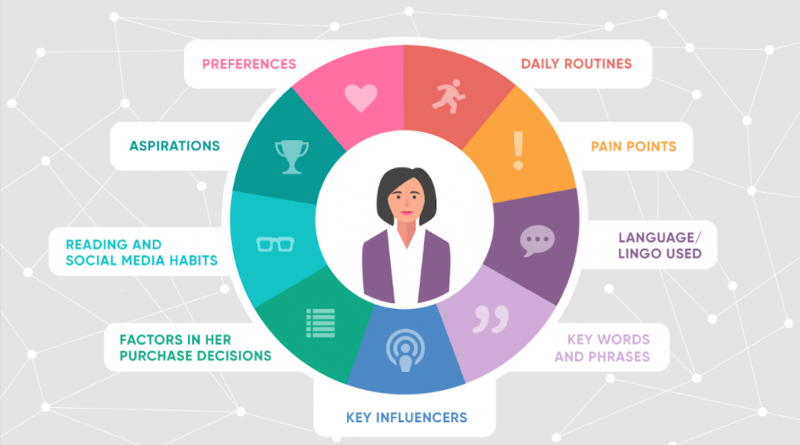
Clearly defining Customer Persona will help you better identify other Customer Journey Map content such as behaviors, emotions, motivations, etc. throughout the product use process.
Step 2: Identify the stages in the Customer Journey
Customer Journey is usually divided into 5 basic stages, which are: Awareness → Consideration → Purchase → Retention → Advocacy . In fact, the above steps may not be sequential, but overlap.
In addition, the stages in the Customer Journey Map also depend on the type of product (online or offline, website or app) and the company’s target audience. Therefore, the customer journey may not include the above basic steps, may be less, more or it may be a completely different journey.
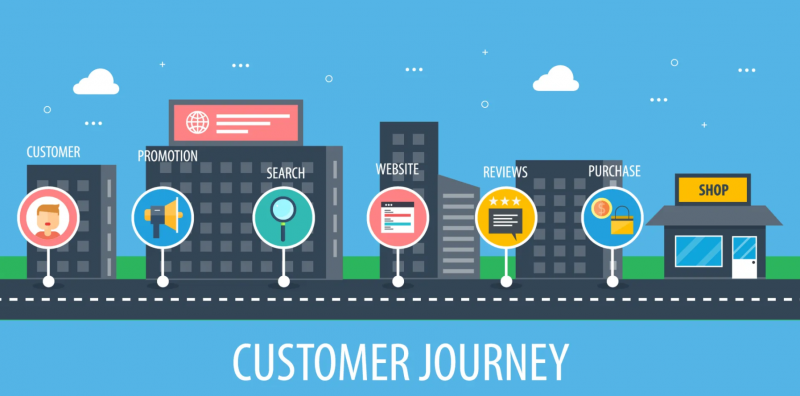
Regardless of the product, your task at this stage is to outline the steps in the customer’s journey to use the product, from the moment it is introduced to the product, to use, and to recommending the product to acquaintances, etc. Fully mapping the customer journey will help you have an overview, identify the Touchpoints (Touchpoints) with customers, thereby designing the best experience for them.
Step 3: Identify Touchpoints with customers
Touchpoint is understood as the connection point between the brand and the customer (for example, website, telesales staff, offline store, …) . Analyzing customer behavior at Touchpoints will help the company make many comments and insights about products and services.
For example, if the conversion rate is lower than average at a certain touchpoint, this means that the customer experience at that touchpoint is not good (maybe the web interface is not favorable, the steps are not good . payment is too complicated, store location is not easy to find,…).
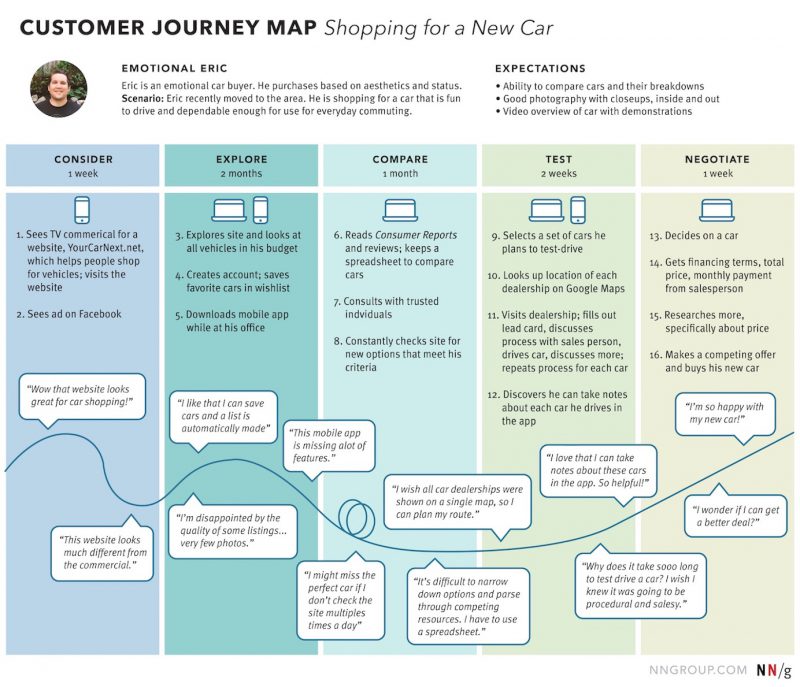
Every touch point between customers and products is a good opportunity for the company to promote its brand image and create a good experience for customers. A good customer experience is summed up by a good experience at many different touch points.
Bước 4: Customer feedback = Action + Emotion + Motivation
One of the main values of Customer Journey Map is that you fully summarize the actions and emotions of customers throughout the Customer Journey, thereby having the clearest and most comprehensive view of the customer experience when using the product.
➤ Action : You list all the actions that customers take during their interactions with the brand through the product or service. Actions here can be as simple as product search habits, what they do when they receive your email, how many steps it takes to pay for an order, etc.

The key here is to determine the number of actions required at the touchpoints for the customer to achieve the goal, and you find ways to (1) increase the customer experience while taking those actions , and (2) improve products to cut out unnecessary actions, helping customers reach their goals faster.
➤ Emotion & Motivation : Every customer action comes from motivation and emotion, in which customer’s emotions change depending on the problem/need they arise from time to time.
Clearly identifying the emotions and motivations of customers at each touchpoint will help the company come up with the right content, features, and strategies at the right time to create the best customer experience. For visualization, you can describe the customer’s emotions on each stage through curves, or lines. At each stage, you will drop an emoji from disappointment to satisfaction to make it easier to visualize.

This information is usually collected from product analysis data (such as Google Analytics, Mixpanel, …) , customer interviews/surveys, customer care team, customer feedback via fanpage, etc.
Step 5: Identify the pain points that still exist on the Customer Journey
On the journey to conquer customers, companies need to identify and understand the Pain points (problems) that customers are facing, the “pains” when using the product that affect the experience with the product. These pain points can be hard-to-find purchase buttons, complicated checkout steps, long page load times, uncharacteristic salespeople, etc.
Pain points that customers experience can be at any stage of the buying journey, and are often found at touchpoints where the customer’s emotions are negative (as identified in step one) . above).
Step 6: Synthesize data and improve the product
After completing the Customer Journey Map, your task is to identify the bad pain points, select the big and urgent pain points to improve the product, increase the customer experience.
However, it should be noted that, building a Customer Journey Map is not a one-time job but a long-term job, and is always improved and modified continuously in the product development journey. Periodically, maybe every quarter or every 6 months, the Customer Journey Map will be reviewed again, and the whole process mentioned above is repeated for the company to continuously optimize the product.

4. 4 PRINCIPLES OF BUILDING EFFECTIVE CUSTOMER JOURNEY MAP
As mentioned, Customer Journey Map (CJM) does not have a fixed template that can be built flexibly depending on product type, business model, customer set, etc. However, a Customer Journey Map needs to ensure adhere to the following four principles.
1. CJM is built from the customer’s point of view, not the company’s
The purpose of this map is to bridge the understanding gap between the company and its users. If you stand from the perspective of the product maker, you will be biased and difficult to understand how most users are actually using the product. Therefore, the process of analyzing and building customer journey maps takes a lot of time and effort, mainly for analyzing user behavior data, interviews/surveys.
2. CJM shows the combination of customer experience and emotions
One of the most valuable points of customer journey maps is that they not only record customer actions, but also express their feelings and thoughts throughout the journey of using the product. This helps the company visualize the customer journey more vividly, providing valuable insights to perfect the product.
3. CJM records the customer’s omnichannel journey
The whole picture of journey maps will show how users reach the product through which touch points. Whether it’s online or offline experience, interacting with products via email marketing or website, buying goods via computer or mobile app, messaging with customer service staff via Zalo or Messenger, etc., those touch points all contribute. important to create a good or bad customer experience.
With a comprehensive perspective, CJM helps you not to miss important touchpoints and interactions, so that in the end, it is still to find ways to improve products/services and increase customer experience.
4. CJM visualizes the customer journey
CJM visualizes a concept that is not as easy to imagine as customer experience into a map, with each specific touch point, each specific interaction, specific emotions, and customer mood charts throughout the process. use the product.
At the same time, CJM also shows the connection between the above factors (touch points, interactions, emotions, motivation, …), helping the team to communicate, present, and analyze the customer journey more easily. , thereby detecting pain points and ways to improve the product more effectively.
5. Choose the right type of map for Customer Journey
In Customer Journey there are all 4 types to build maps. Depending on the intended use, you can choose the appropriate type:
Current State
This is the type of journey map most businesses use. It describes the behavior, thoughts and feelings of customers during their interactions with the business. This type of map is used to improve the customer experience when using a product/service.
Day in the Life
This map is more specific, depicting a customer’s behavior, thoughts and feelings during a typical day. This experience may or may not be related to your company’s product/service. This type of map is effective for businesses to find the hidden needs of customers, even if they do not know the existence of that need.
Future State
This map helps businesses forecast customer behavior, thoughts and feelings in the future. Based on the information you have now, this is how you guide and improve the customer experience later.
Blueprint
Blueprint starts by listing out a diagram similar to one of the four types of customer journey maps above. It then stratifies the factors that influence the customer’s interactive experience, including people, technology, mechanisms, and processes.
Blueprint is suitable for you to find the root of the problems that customers are facing, precisely meeting the needs and wants of customers now and in the future.
6. Analyze data from the map
Creating a customer journey map is not enough, you need to analyze and read the meaning behind the data you have just collected.
Example: How many customers view a product a day without making a purchase? What is the bounce rate of visitors on the website? At what touchpoint do they exit? Is the customer service really good or not?
Accurate root cause analysis can help you find the root of the problem, providing exactly what your customer is looking for.
To have accurate data, you need to closely monitor the channels of interaction with customers, from social networking platforms, reading customer emails, to tracking mentions on the Internet.
7. Change as needed
The psychology, behavior and needs of customers change every day. You need to have an open mind, flexibility to respond to this constant change.
Whether the change is big or small, as long as it’s effective, you should apply them to the map. Try to review the customer journey map quarterly, or monthly to shorten the distance with customers.
Many factors can influence the change of customer journey, such as customer tastes, evolving technology, new competitors, or even the launch of new products within the business.
8. Good example of Customer Journey map
To make it easier for you to visualize, here are a few examples of customer journey maps. Maybe you can apply them in your case:
Customer Journey Map for B2B Businesses
This map highlights the 5 stages in which customers approach and make a purchase decision, going from research, comparison, skepticism, hesitation to rejection/purchase.
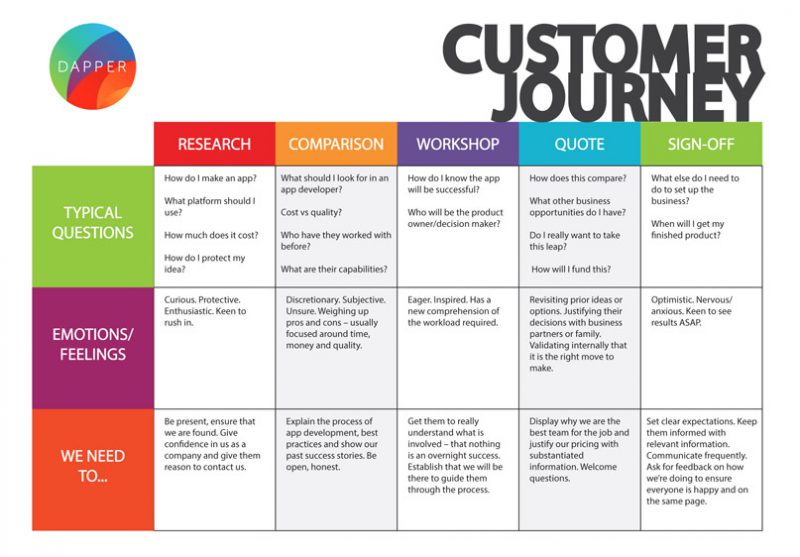
By asking questions customers often ask in each stage, employees in the business can see exactly what customer insights are at that time. From there, offer solutions to interact with customers effectively.
Customer Journey Map for Ecommerce
Here is a typical Customer Journey map example using the Day in the Life type.
Instead of focusing on customer behavior and insights when interacting with businesses at touchpoints, this map focuses on customer behavior during an ordinary day.

This map is useful for businesses to find the hidden needs and wants in each customer. From there, “take a shortcut” to get a reasonable method of interacting with guests.
Customer Journey Map for B2C Business
Here is a very detailed example from Carnegie Mellon University, outlining a forecast of future customer behavior and thoughts. This map includes customer behavior, touch points they choose to interact with, factors that influence their decisions, and a few possible scenarios.
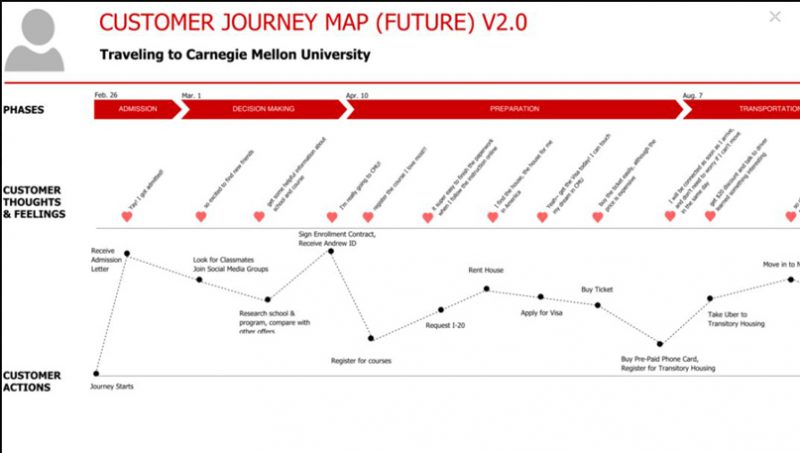
This map is useful for businesses to build scenarios of future customer interactions. From there, there are appropriate behaviors and handling.
You can check out the full version here .
Customer Journey Map for Retail Businesses
The map below shows how customers interact with a hypothetical restaurant. This is a description of the steps that a restaurant must take to meet the common needs of customers when coming to dine.
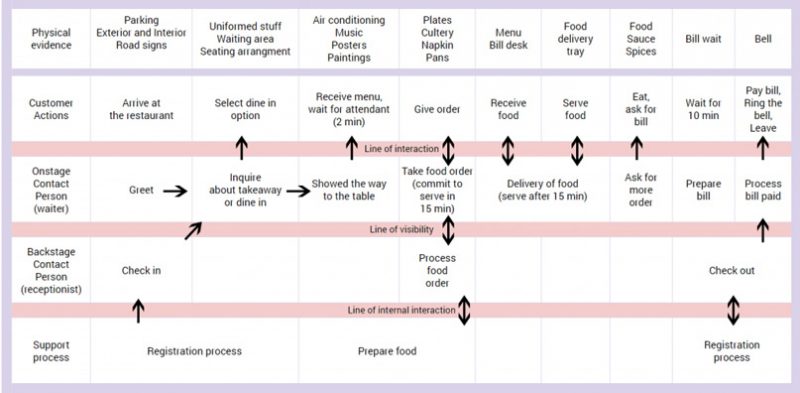
Therefore, this map is somewhat more complicated than the examples above.
9. Customer Journey map template template
To help you easily build a customer journey map, Malu would like to send you some sample templates here .

Hope these templates can help you in interacting and reaching out, improving sales and brand recognition from customers.
SUMMARY
Above are 6 important steps and 4 principles to keep in mind to build an effective Customer Journey Map. Depending on the industry, target customer and purpose, the implementer will have to adjust and supplement the above steps to get a suitable and effective map. Furthermore, the process of building a Customer Journey Map is complex and time-consuming, so listen carefully to your customers, and get to know them well.
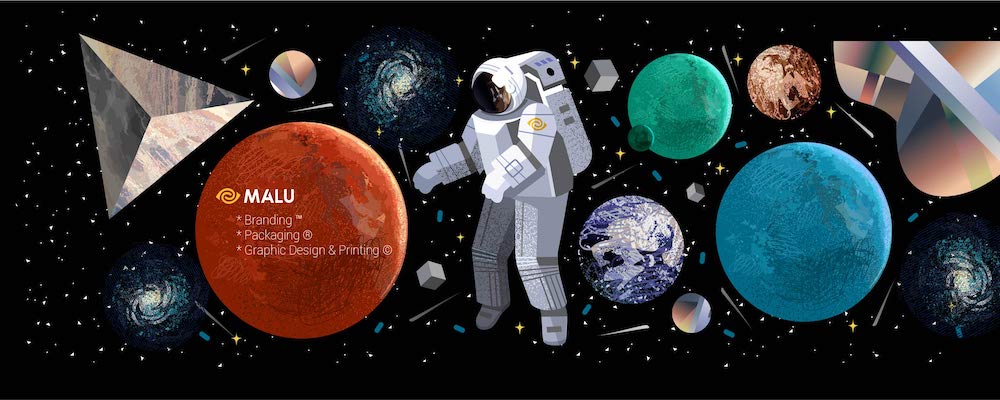
If you are looking for a reputable and experienced unit to be able to design a professional and impressive logo and brand identity system , then please contact us immediately by phone. 0988 622 991, or leave your information and requirements, Malu Design ‘s consulting department will contact you right away to answer all your questions!
————————
Malu Design – Branding Identity Agency
Hotline: 0988 622 991




